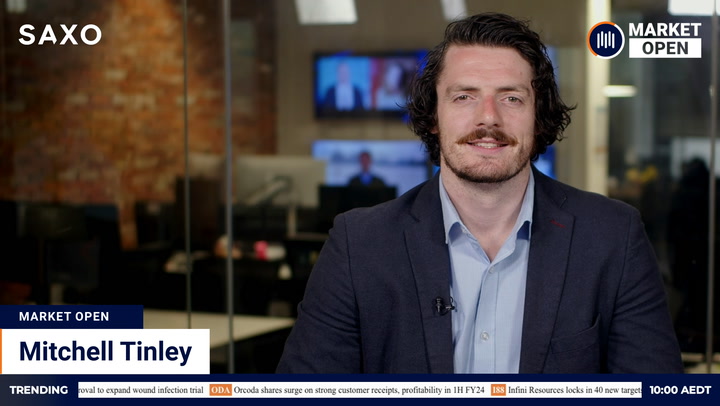A new financial year looked set to open with a modest share market rebound despite pressure on commodity prices and a grim end to Wall Street’s worst first half since 1970.
ASX futures bounced 12 points or 0.19 per cent as US stocks finished off overnight lows. The S&P/ASX 200 slumped almost 2 per cent yesterday as the curtain fell on a losing fiscal year.
Overnight, iron ore, oil and gold continued to retreat. Industrial metals added to their worst quarterly decline in a decade. The dollar regained 69 US cents.
Wall Street
US stocks continued to lose ground as economic data did little to allay fears the economy was heading for recession as consumer prices remain near 40-year highs.
The S&P 500 fell 33 points or 0.88 per cent. The Dow Jones Industrial Average shed 254 points or 0.82 per cent. The Nasdaq Composite lost 149 points or 1.33 per cent.
The declines secured a series of unwelcome milestones for the major indices. The S&P 500 had its worst start to a year since 1970. The Dow’s loss was the biggest in percentage terms since 1962. The Nasdaq’s January-June run was its worst on record.
“A disappointing last day of June caps a rough first half of the year for US stocks with losses of some 15% for the Dow, 20% for the S&P and 30% for the NASDAQ. The silver lining: Government bonds finally offer more risk mitigation. The hope: Genuine value is gradually being created,” tweeted chief economic advisor at Allianz, Mohamed A. El-Erian.
Consumer spending increased less than expected in May as Americans turned cautious in the face of surging prices. The rise of 0.2 per cent was the smallest in five months and less than half the increase expected by economists.
Data for earlier months were also revised lower. Consumer spending makes up about 70 per cent of the US economy.
“It should really come as no surprise that U.S. consumers are paring their spending due to the high costs of, well, almost everything,” senior economist Jennifer Lee of BMO Capital Markets said. “So that means slower momentum as the second quarter began.”
The slowdown came as inflation remained near this year’s 40-year high. The personal consumption price index increased by 0.6 per cent in May. Core inflation backed down to an annual rate of 4.7 per cent from 4.9 per cent in April and a 40-year high of 5.2 per cent in March.
The yield on ten-year US treasuries dropped briefly below 3 per cent for the first time in three weeks, easing pressure on borrowing-dependent growth stocks.
Cryptocurrency-related stocks slumped as Bitcoin fell below US$19,000. The best-known of the digital currencies was lately down 7.3 per cent at US$18,693.
Australian outlook
Futures action suggests the S&P/ASX 200 should recoup a portion of yesterday’s near-2 per cent EOFY tumble. Around a third of yesterday’s 132-point loss came in the closing auction when institutional investors find deeper trading volumes. That suggests some of that loss was more about portfolio adjustments than genuine selling.
There was not a lot else in the overnight action to encourage optimism about the day ahead. The start of a financial year offers the semblance of transition, but other than relief from tax-loss selling, little has changed.
Iron ore, metals and crude continued to decline. The dollar continued to dance around 69 US cents, lately up 0.36 per cent at 69.03 US cents. Wall Street’s main indices continued to lose altitude despite a modest intraday recovery.
The night’s best-performing US sectors were utilities +1.1 per cent, industrials +0.28 per cent and real estate +0.03 per cent.
Everything else closed lower. Energy sank 2.04 per cent, technology 1.33 per cent, materials 1.23 per cent and financials 0.88 per cent.
Back home, the Australian Industry Group releases June manufacturing figures at 8.30 am AEST. Activity slowed significantly last month, so expectations are modest.
Commodities
Industrial metals wrapped up their worst quarter in more than a decade with further declines as rising rates threaten demand. Covid lockdowns in China and slowing growth put an end to the post-pandemic boom.
Overnight, benchmark copper on the London Metal Exchange dropped 1.7 per cent to US$8,254.25 a tonne. Aluminium and lead lost 1 per cent, nickel 4.7 per cent, zinc 6.2 per cent and tin 1.6 per cent.
The falls completed a wretched quarter. Copper and aluminium have fallen around 30 per cent on the LME, tin 39 per cent, nickel 29 per cent, zinc 24 per cent and lead 20 per cent.
“We still see metals falling as a recession in the U.S. is fully priced in,” Commerzbank analyst Daniel Briesemann said.
Iron ore extended its quarterly loss beyond 10 per cent amid concerns about faltering demand for steel in China. The most-traded ore contract on the Dalian Commodity Exchange dropped 2.2 per cent to 791 yuan a tonne.
The spot price for ore landed in China dipped 11 US cents or 0.1 per cent to US$130 a tonne. Coking coal skidded 6.1 per cent.
Oil added to a monthly loss as recession worries capped buying interest. The most active Brent crude contract settled US$3.42 or 3 per cent lower at US$109.03 a barrel.
The expiring August contract lost 6.5 per cent for the month. But despite recent pressure, Brent prices are almost 48 per cent higher this year.
Gold fell for a fourth night, settling at its lowest since February. Metal for August delivery settled US$10.20 or 0.6 per cent in the red at US$1,807.30 an ounce. The NYSE Arca Gold Bugs Index slumped 4.3 per cent.
The gold price declined 2.2 per cent in June and 7.5 per cent across the quarter. For the year, the yellow metal is down 1.2 per cent.
BHP‘s US-traded depositary receipts sank 3.45 per cent. The miner’s UK listing dropped 3.61 per cent. Rio Tinto shed 3.07 per cent in the US and 3.56 per cent in the UK.





